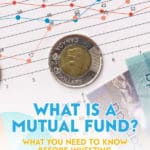What Is A Mutual Fund? What You Need to Know Before Investing

Amidst the rising popularity of low-cost investments like Exchange Traded Funds (ETFs), mutual funds remain popular with Canadian investors. It should come as no surprise, really. For every investor rushing to open a discount brokerage account to buy up the latest trending technology stock, there are thousands who still prefer the simplicity of mutual fund investing. Mutual funds have their drawbacks, but they continue to be an easy way for investors with small to medium-sized portfolios to gain access to the markets within a professionally managed, well-diversified portfolio.
Mutual Fund Definition
Mutual funds are a pooled investment comprising money that’s contributed by thousands of investors. The funds are used to invest in money market investments, income trusts, stocks and bonds, and other securities. Mutual funds are managed by a team of investment professionals in accordance with a predetermined investment objective, which is laid out in a document called a fund prospectus.
How Do Mutual Funds Work?
Investors buy units, or shares, of a mutual fund. The unit price rises and falls in value depending on the performance of the underlying securities that are held in the fund. Every mutual fund has its own investment objective, which influences the types of securities held in the fund. Securities are chosen based on a broad range of factors, such as asset class, industry sector, geographic allocation, and many more. Unlike many other investments, mutual funds are open-ended. In other words, as more people want to invest, additional units or shares are issued by the fund.
What Are The Benefits of Investing In A Mutual Fund?
Mutual fund investing holds many benefits, which is why it’s become a 1.5 trillion dollar industry in Canada. Here are a few advantages of mutual fund investing.
It’s a simple way to invest. Mutual fund investing is ideal for new investors due to the simplicity. All you need to worry about is choosing the fund(s) that fit your investor profile. From there, all of the decision making, from individual security selection to rebalancing, is made on your behalf by the fund manager.
Diversification. One of the most important rules of investing is to make sure your portfolio is diversified. In other words, you should never place all of your eggs in the same basket. With mutual funds, you get the benefit of diversification as the fund holds numerous securities in various asset classes, industry sectors, and geographic regions. Diversification reduces the risk of a portfolio because if one security drops in value, others will continue to provide positive returns.
Low minimum investment. You can purchase mutual funds in as little as $25 increments by setting up a pre-authorized purchase plan with your investment dealer. Such a low barrier to entry makes it possible for just about anyone to invest in the markets.
Professional Management. Because mutual funds are professionally managed, it means that you have very little to worry about once you purchase the funds. Without mutual funds, you would have to pay an arm and a leg to obtain the same level of expert oversight with your investments. In fact, it’s an expense many would not be able to afford.
Automatic Rebalancing. Mutual fund rebalancing is a routine process whereby the fund manager adjusts the underlying holdings of the fund to ensure that the proper asset allocation is maintained. For example, let’s say you own units of a balanced fund which has an allocation of 60% stock and 40% bond. If the stock market has a very strong year while bonds remain flat, your asset allocation could be skewed at the end of the year, to something more aggressive than you’re comfortable with. Your 60/40 could look more like 75/25.
In this case, the fund manager would adjust the holdings accordingly in order to realign to a 60/40 allocation. This could involve selling off some of the stock gains, or purchasing more bonds, or a combination of both.
Drawbacks of Mutual Fund Investing
Alongside the many benefits, mutual fund investing has a few drawbacks. Here are a few things to consider before deciding to add mutual funds to your portfolio.
They can lose value. Because mutual funds purchase underlying securities that rise and fall in value, such as individual stocks, the price of a mutual fund unit also fluctuates in value. Fund performance is not guaranteed which means that technically speaking, you could lose money if you sold the fund at a lower price than you bought it for.
They can be expensive to own. More than ever, investors are becoming aware of the impact of fees on their overall returns over the long term. Actively traded mutual funds tend to have high administrative costs, an expense that is passed along to unitholders of the fund in the form of a Management Expense Ratio (MER). It’s not uncommon for the MER of an equity mutual fund to charge over 2% on an annual basis.
In addition to MERs, the investor may be subject to a sales commission when they purchase a mutual fund. These are often referred to as a front end or back end load charge.
Lack of control. What makes mutual funds so simple, can be a source of frustration for some. Because the holdings of a mutual fund are fully controlled by the fund manager, investors who prefer to have full control over their portfolio may want to avoid mutual funds in favour of purchasing individual stocks and bonds.
Types of Mutual Funds
Mutual funds can be purchased across all asset classes. As a result, there is a mutual fund that is suitable for any type of investor, from the most conservative to aggressive growth. Here’s a description of each mutual fund type.
Money Market Funds
Money market funds invest in government or corporate secured investments with terms of less than one year. Because the underlying investments are short term instruments of high quality, money market funds are considered to be very low risk. Their returns reflect this as well. An ideal money market investor is someone who prioritizes the preservation of capital and is less concerned with returns.
Bond Funds
Bond funds, often referred to as income funds, buy and sell different types of government and corporate bonds. These are considered low-risk investments with superior return potential to that of a money market fund. That said, there is some risk to bond funds due to something called interest rate risk.
Equity Funds
An equity mutual fund is one that buys and sells the stock of individual companies. The primary goal of an equity fund is growth. Owners of an equity mutual fund are willing to take on more risk in order to earn higher returns over longer periods of time. Equity funds range from medium to high risk.
Balanced Funds
A balanced fund is one which holds investments from both the income and equity asset class. Typically, the manager of a balanced fund is looking to balance long term capital growth (stocks) within moderate levels of risk (bonds). A balanced mutual fund can be a great way to reduce portfolio volatility while maintaining the potential for higher returns over the long term.
Understanding Mutual Fund Fees
As I mentioned previously one of the drawbacks to investing in mutual funds is the fees. Investors will pay an annual fee in the form of an MER. This varies, depending on how active the mutual fund happens to be, but it can range between 1% and 3%, enough to take a significant bite out of your returns over time.
Index Mutual Funds
One way to invest in mutual funds without paying such high fees is by purchasing index funds. These are passively managed funds that are designed to mirror an underlying index, such as the TSX/S&P 500. Because the fund manager is simply buying the securities held by the index, the administrative costs are reduced, resulting in a lower MER.
Two examples of index funds in Canada would be the TD eSeries of funds, or Tangerine Funds, courtesy of online banking giant Tangerine. With either of these options, you can buy mutual funds with MERs well below 1%.
How to Invest In Mutual Funds
There is no shortage of ways to invest in mutual funds. If you prefer, you can meet with an investment advisor at any bank or credit union. All of Canada’s big banks have their own proprietary mutual funds to choose from, which is where they will steer you if you deal with them directly. If you are comfortable investing online, I recommend opening an account with a discount brokerage like Questrade. This way you’ll have access to purchase thousands of commission-free mutual funds, as well as ETFs. Once you’re ready to tackle individual stocks, you can access them in the same account.
Earlier, I mentioned index mutual funds, specifically Tangerine Funds and TD e-Series. Tangerine Funds can be purchased directly on their website, while TD e-Series are available in several discount brokerage accounts. With so many ways to invest in mutual funds, there’s no reason to wait.

